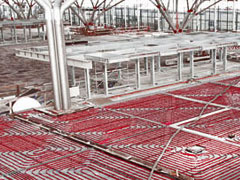Underfloor Heating
Underfloor heating ("UFH") is an efficient method of distributing heat evenly into a building to provide comfortable space heating. Lower temperatures (around 40°C) can be distributed over a larger area than the higher temperatures (around 70°C) needed for wall-mounted radiators.
Underfloor heating is invisible and clutter-free and radiates heat gently from ground level to avoid the convection losses and draughts generated by wall-mounted radiators.
A well installed underfloor heating system can save over 30% of fuel costs and CO2 emissions compared to using traditional wall-mounted radiators. It holds the further advantage that it is a good match for ground source heat pumps which can also reduce the annual cost of heating. This is because a GSHP will deliver a higher coefficient of performance with the lower delivery temperature used in underfloor heating.
Space Heating
A Ground Source Heat Pump ("GSHP") is used to extract heat from the ground and transfer it into a building to provide space heating.
GSHPs are now established technology with over a million installations (largely in North America, Sweden, Switzerland and Germany). GSHPs are emission free at the point of use and need no flue or chimney. A GSHP can achieve a coefficient of performance of 4 if used in conjunction with a low temperature delivery system like underfloor heating.
An "unassisted" GSHP can compete economically with conventional oil fired heating or electric storage heating. Gas fired heating may be cheaper than an ordinary GSHP installation, although a GSHP will have significantly lower CO2 emissions. These emissions are decreasing as the grid decarbonises.
Solar Heating – Solar Assisted Ground Source Heat Pump – SAGSHP
It is possible, however, to double the CoP of a GSHP if used with an ICAX ThermalBank. A full Interseasonal Heat Transfer System (incorporating a solar collector, ThermalBank and GSHP) can show a lower annual heating cost than a gas fired boiler and can save over 50% of carbon emissions compared to a gas fired boiler. Using IHT is the key to energy savings in buildings.
Coefficient of Performance
The coefficient of performance ("CoP") is a measure of the efficiency of a given heat pump under standard conditions: the change in heat delivered over the electricity consumed. However, the CoP will vary greatly under different conditions: a modern heat pump should achieve a CoP of 4 if starting from a temperature of 10°C from the ground and delivering 40°C to underfloor heating. If the same pump starts from a temperature of 25°C from a ThermalBank it will have half as much work to do to achieve a 40°C output temperature, and this will double the CoP achieved.
Heat Capture and Storage
Interseasonal Heat Transfer works by capturing heat energy from the sun via a collection pipe network just beneath the surface of black tarmac roads (or car parks or school playgrounds). It then stores the energy in computer-controlled Thermal Banks in the ground under the foundation of buildings, and releases it to heat the buildings in winter via heat pumps linked to underfloor heating.
ICAX uses a ground source heat pump to extract heat from the ThermalBank when it is needed to heat the building in winter. Unlike a normal ground source heat pump which typically starts with an autumn ground temperature of 10°C the heat pump in an Interseasonal Heat Transfer system starts with a temperature of over 25°C from the ThermalBank.
This doubles the Coefficient of Performance of the heat pump and allows a 50% saving of carbon emissions compared to providing heat from a gas boiler.
In addition, IHT can provide "Free Cooling" to extract some heat from buildings in summer at very little cost, or full active cooling using the principles of IHT in reverse.
IHT also offers the chance to provide critical period cooling – for the few weeks when cooling is desirable in the UK – at a much lower capital cost than full air conditioning, and a much lower revenue cost. Having invested in IHT for heating, there is only a marginal extra cost needed to provide "critical period cooling" as well.
Integrated heating and cooling system
Part of the extra cost reflects the need for the underfloor pipes to be laid closer together for effective cooling: the closer spacing needed for cooling also makes the pipes more efficient for heating. This allows a lower temperature to be used and contributes to an even higher CoP when IHT is in heating mode.
See also: Renewable Heating
See also: Renewable Cooling
See also: Banking on IHT
Advantages of Underfloor Heating:
Comfort – even spread of heat provides a high level of comfort.
Economy – reduced heat demand with no wasted heat at ceiling height.
Cost-efficiency – reduced on-site maintenance.
Flexibility – unrestricted wall surfaces in both old and new buildings.
Safety – no hazardous wall projections or hot surfaces.
Control – comprehensive controls packages offer solutions for the majority of buildings.
Underfloor heating disadvantages:
There are no disadvantages of using underfloor heating to distribute heat in a building. There is a greater cost of installation - and the cost of disruption of installing underfloor heating as a retrofit.
Underfloor Heat Collector
The piping that provides underfloor heating can also be used as an Underfloor Heat Collector.
ICAX Solar Runway Systems
ICAX also uses the principles of under road heating to keep airport runways free of ice and snow. See Solar Runways and Solar Roads.
Zero Carbon Emissions
Interseasonal Heat Transfer in conjunction with underfloor piping can provide gas free heating.




